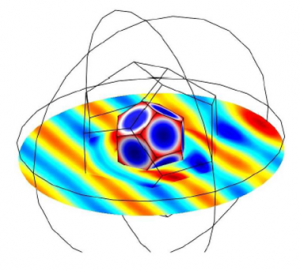By Frank Kuo
This post originally appeared on CLEO BLOG by Frank Kuo and is reproduced with permission from its author.
 Figure 1. An invisibility cloak made by a faceted dodecahedral. This simulation shows that the plane wave can propagate through it without too much distortion and objects can be hidden inside the dodecahedral. Courtesy of Oliver Paul, Yaroslav Urzhumov, Christoffer Elsen, David Smith, and Marco Rahm.
Figure 1. An invisibility cloak made by a faceted dodecahedral. This simulation shows that the plane wave can propagate through it without too much distortion and objects can be hidden inside the dodecahedral. Courtesy of Oliver Paul, Yaroslav Urzhumov, Christoffer Elsen, David Smith, and Marco Rahm.
Various forms of metamaterial have generated a lot of scientific attention in the past few decades. Some exciting “potential” applications include the well-publicized invisibility cloak (Thanks to Harry Potter). As you may know already, metamaterial gains its bizarre optical property (such as negative index of refraction) by its internal composition or structure, rather than its original physical property. Most metamaterial has its magic only in specific wavelength region and this wavelength region is correlated to how small you can make the internal structures of the metamaterial. This is exactly why almost all the research on metamaterial focuses on THz region since THz has very long wavelength and we do not need to make the structures awfully small to concoct the magic (I did read some articles about “universal metamaterials”, but it seems a long way to go. Let’s dream of that coming in CLEO 2012).
Digging into more details, you can have 2D or 3D metamaterial depending on your applications. 2D metamaterial – or so called metamaterial tiles (m-tiles) – seems to make a huge leap in guiding the advance in the invisibility cloak and sensing platform. And they are easier to make (through the help of photo-lithography, or micro-machining on the surface). With this powerful combination, a booming in this field seems inevitable. Let us take a peek of its potential application in invisibility cloak first: Continue reading »
Posted: 15 November 2011 by
Frank Kuo
| with 0 comments